Vietnamese Steamed Pork Buns: The Most Delicious Street Food In Vietnam
Thursday, June 13, 2024
Food & drink
Among the many delights of delicious street food in Vietnam, the steamed pork buns, frequently earn high praise for their exceptional taste. With their pillowy soft dough and flavorful pork filling, they capture the heart of Vietnamese cuisine. Trying bánh bao is a must for anyone seeking to dive into the country's rich culinary heritage. Join Autour Asia as we delve into what makes this beloved dish the most delicious street food in Vietnam.
Table of Contents
1. What make Vietnamese steamed pork buns special?
Vietnamese steamed pork buns, known locally as Bánh Bao, are a beloved staple in Vietnam's rich culinary tradition, most delicious street food in Vietnam, which first honoured name on Lonely Planet's list (World famous travel guide). These buns are celebrated for their unique blend of flavours and textures - savoury meat, aromatic seasonings, and a slightly sweet dough that come together to create a harmonious eating experience. Each Vietnamese steamed pork bun is a delightful treat, encasing a flavorful mixture of seasoned ground pork, onions, and wood ear mushrooms within a soft, pillowy dough. Often, slices of Chinese sausage and a segment of hard-boiled egg are added to enhance the richness of the filling.
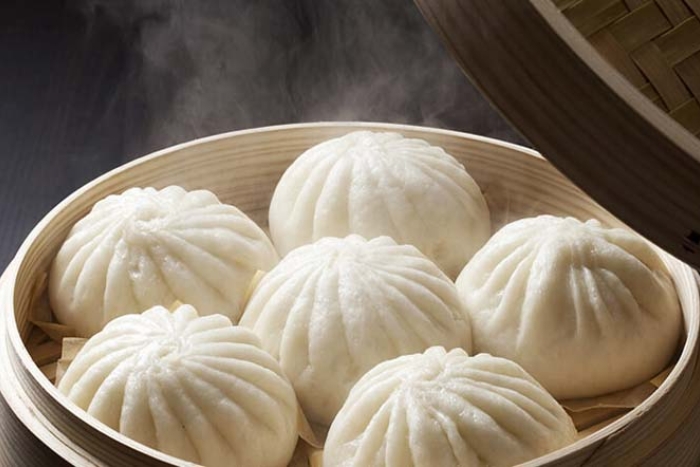
The dough, slightly sweet and made from wheat flour leavened with yeast, steams to a tender, fluffy texture that perfectly complements the savoury filling. Bánh Bao are more than just a popular street food in Vietnam, they are also a staple in home cooking, reflecting the communal and familial aspects of Vietnamese dining culture. They are commonly enjoyed as a snack or a quick meal, embodying convenience with their self-contained design. This makes them ideal for on-the-go eating, whether on busy city streets or at family gatherings.
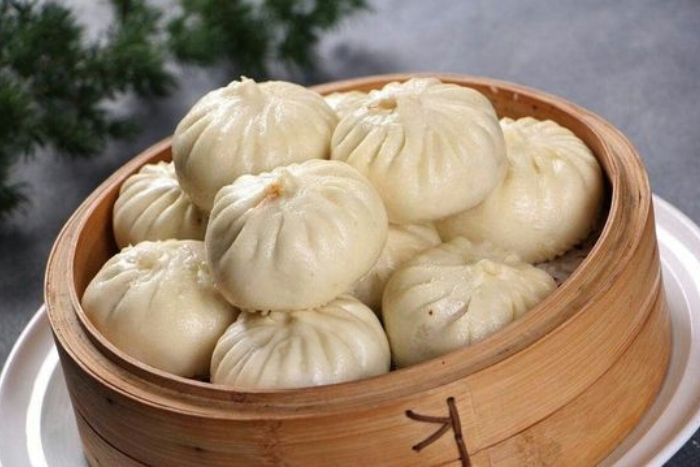
Simply, it’s convenient: you can eat it for breakfast, for snack, and big enough to consider it a light lunch or dinner, at home, on the road, everywhere. This is probably the most popular Chinese dish that is loved by Vietnamese.
2. The most popular types of Banh bao in Vietnam
In Vietnam, the culinary landscape is rich with diverse and flavorful varieties of bánh bao, each offering unique tastes and textures that cater to different palates. Here are some of the most beloved versions of bánh bao, each distinguished by its distinct fillings and flavours:
Traditional Vietnamese Steamed Pork Buns (Bánh Bao Thịt):
It is the most commonly enjoyed Vietnamese steamed pork buns across Vietnam, beloved for its traditional flavours and satisfying texture. This quintessential version of bánh bao is generously filled with seasoned ground pork, finely chopped onions, wood ear mushrooms, slices of Chinese sausage, and a segment of hard-boiled egg, creating a savoury and hearty flavour profile.
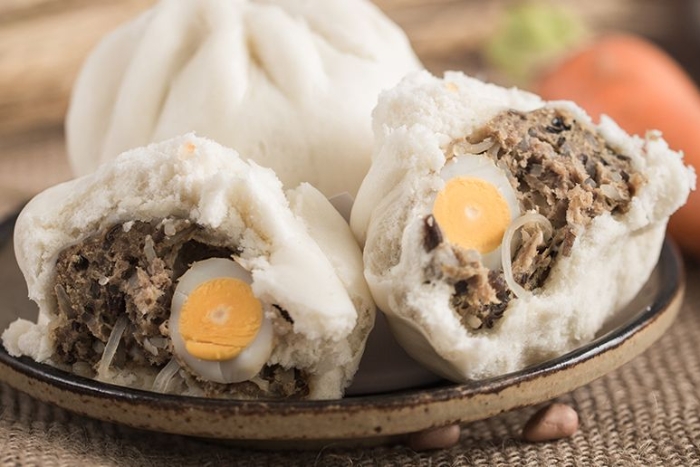
Vegetarian Steamed Pork Buns (Bánh Bao Chay):
Tailored for vegetarians, this steamed vietnamese buns variant uses a mixture of tofu, assorted mushrooms, glass noodles, and diced vegetables such as carrots and peas. The ingredients are seasoned with soy sauce, sesame oil, and a blend of spices, offering a rich umami experience. It's a popular choice for those seeking a plant-based option without sacrificing depth of flavour.
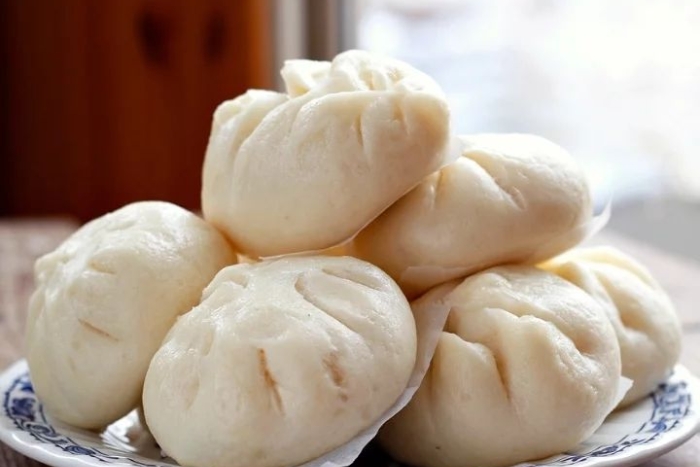
- Sweet Bánh Bao (Bánh Bao Ngọt):
Often enjoyed as a dessert or a teatime snack, they are a favourite among those with a sweet tooth. These sweet treats are filled with a smooth paste made from mung beans or a mixture of coconut and sugar, providing a pleasantly sweet end to a meal or a delightful snack during the day.
- Steamed BBQ Pork Buns (Bánh Bao Xá Xíu):
It's a testament to the fusion of Vietnamese and Chinese flavours, popular in areas with significant Chinese communities.Drawing inspiration from Chinese culinary traditions, this bánh bao features succulent pieces of char siu pork, which is pork marinated in a complex sweet and savoury sauce and then roasted to perfection. The filling is both flavorful and slightly sweet, with a hint of smokiness.
- Salted Egg steamed Pork Buns (Bánh Bao Kim Sa):
This innovative variant incorporates a creamy salted egg yolk into the traditional pork filling, offering a burst of rich, savoury flavours that perfectly balance the sweetness of the dough. With the distinctive taste, the salted egg enriches the filling, providing a luxurious taste sensation that is both unique and memorable.
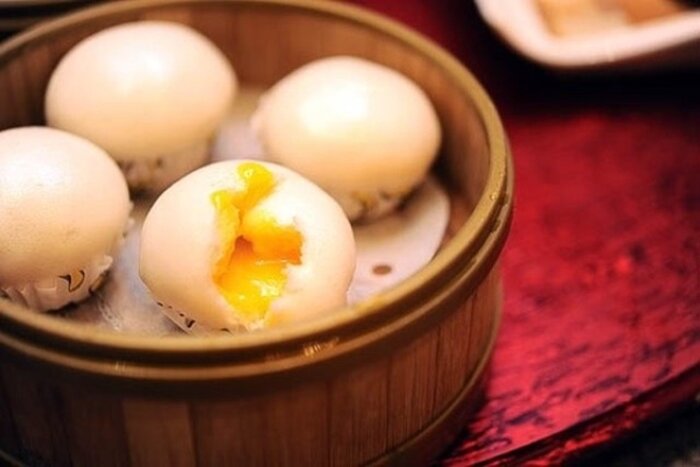
Each type of bánh bao not only reflects the versatility of Vietnamese cuisine but also showcases its ability to embrace and adapt influences from various culinary traditions, creating distinct and memorable eating experiences for both locals and visitors alike.
3. How to make Vietnamese steamed pork buns?
a. The ingredients of Vietnamese banh bao
The ingredients for Vietnamese steamed pork buns consist of all-purpose flour, sugar, yeast, milk, and a pinch of salt, which together create the soft, fluffy dough. The savoury filling typically includes a mixture of ground pork, onions, mushrooms, and hard-boiled quail eggs, seasoned with fish sauce, soy sauce, sugar, and pepper. For added flavour and variety, optional ingredients such as Chinese sausage and glass noodles can also be incorporated.
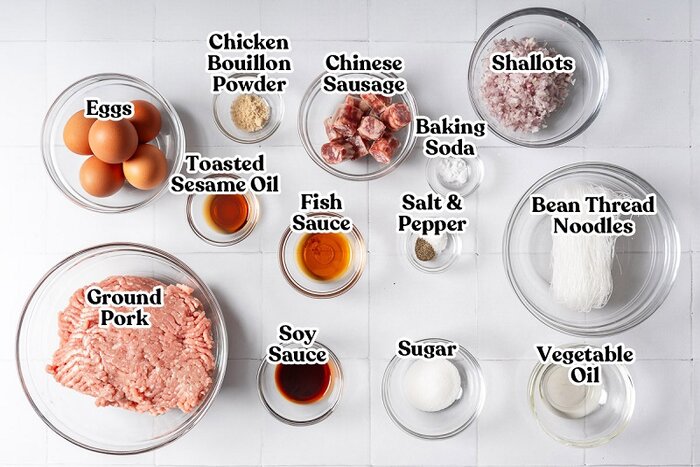
b. Vietnamese banh bao recipe
Bánh bao, a popular Vietnamese steamed bun, is renowned for its soft, fluffy exterior and savoury filling. With the Vietnamese banh bao recipe, let's begin by preparing the dough with all-purpose flour, sugar, yeast, milk, and a pinch of salt. Knead the dough until it is smooth and elastic, then allow it to rise until it doubles in size, ensuring a light and airy texture.
For the filling, combine ground pork with sautéed onions and mushrooms, and include hard-boiled quail eggs. Season the mixture with fish sauce, soy sauce, sugar, and pepper. Optional additions like Chinese sausage or glass noodles can enhance the flavour. After the dough has risen, divide it into portions, flatten each piece, and wrap it around a spoonful of filling, sealing the edges tightly.
Place each filled bun on a square of parchment paper in a steamer basket, leaving space for expansion. Steam the buns for 15-20 minutes until the dough is soft and fluffy. Bánh bao is best enjoyed warm and serves as a delightful breakfast, snack, or light meal, perfectly embodying the rich culinary traditions of Vietnam.
c. Some useful tips for making Vietnamese steamed pork buns
When making Vietnamese bánh bao, a few key tips can ensure the best results:
- Dough Preparation: Activate the yeast properly by dissolving it in warm milk (around 110°F or 43°C) with a bit of sugar. Let it sit for 5-10 minutes until frothy. This step ensures the dough rises well and achieves a fluffy texture.
- Filling: For a more flavorful filling, sauté the onions and mushrooms before mixing them with the ground pork and seasonings. Ensure the filling is not too wet to prevent the buns from becoming soggy.
- Shaping and Steaming: When wrapping the dough around the filling, pinch the edges tightly to seal the bun completely. Let the filled buns rest for 10-15 minutes before steaming. Place each bun on a square of parchment paper to prevent sticking. Steam over medium-high heat, ensuring enough space for the buns to expand, and avoid opening the lid during the first few minutes to maintain consistent steam.
By following these tips, you can make delicious, fluffy bánh bao that capture the authentic flavours of this traditional Vietnamese dish.
In conclusion, Vietnamese steamed pork buns stand out as a quintessential delight in Vietnam's street food landscape. Their perfect balance of fluffy dough and savoury filling makes them irresistible to food lovers. For anyone exploring Vietnam's rich culinary traditions, Bánh bao is an absolute must-try, embodying the essence of the country's vibrant and flavorful street food culture. Contact Autour Asia - Vietnam travel company immediately if you want to have unique experiences and trips beyond your expectations.
You might consider consulting the subsequent trip:
>>> Vietnam Trip Package Deals 14 Days
>>> Vietnam itinerary 3 weeks
>>> Vietnam travel tour packages & beach days
>>> All Vietnam Packages Tours
>>> Vietnam Trip Package Deals 14 Days
>>> Vietnam itinerary 3 weeks
>>> Vietnam travel tour packages & beach days
>>> All Vietnam Packages Tours
Related travel guide
Other similar articles
CUSTOMIZABLE BY LOCAL EXPERTS
Personalized trip at the original price!
REFUND GUARANTEE
We believe in our work and promise to give you money back.
GOOD PRICE / QUALITY
95% satisfied more than expected!
24/7 LOCAL SUPPORT
We are always available online to provide assistance at any time.
Most read articles
Autour Asia is highly recommended on
Embracing the mission of "Satisfied more than expected" and providing authentic experiences, we have received numerous recommendations on reputable travel forums:























